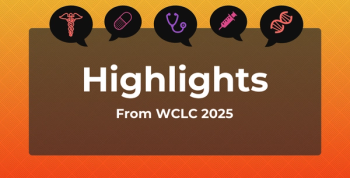
Dr Joshua Sabari Discusses Amivantamab’s First-Line Approval for NSCLC

The approval converts the May 2021 accelerated FDA approval for second-line treatment of non–small cell lung cancer (NSCLC) with EGFR exon 20 insertion mutations to a full approval in the first line following results from the phase 3 PAPILLON study.
In May of 2021, the FDA granted
The American Journal of Managed Care® spoke with Joshua K. Sabari, MD, oncologist, NYU Langone Perlmutter Cancer Center, and PAPILLON study investigator about the approval and what these developments could mean for patient survival moving forward.
“Really, there have been no standard targeted therapies approved in the frontline setting,” Sabari states. “Most people have been using some combination of chemo or chemotherapy and immunotherapy, and we know that the response rate, as well as the progression-free survival, in this patient population is pretty dismal.”
Transcript
Can you discuss the PAPILLON study’s investigation?
The PAPILLON study is a randomized phase 3 international study comparing amivantamab, an EGFR and cMet bispecific antibody, plus chemotherapy vs chemotherapy alone in patients with EGFR exon 20 insertion–mutant non–small cell lung cancer. This was the first frontline trial using a targeted therapy in the EGFR exon 20 space.
What are your key study findings, particularly regarding the clinical advantages of adding amivantamab to chemotherapy?
EGFR exon 20 insertion–mutant non–small cell lung cancer is quite rare. It occurs in about 1% to 2% of patients with lung cancer, and we know that these patients have poor overall prognosis. There's no standard targeted therapies that have been effective in this patient population. Amivantamab, in the CHRYSALIS cohort D study, showed about a 40% response rate and a median progression-free survival of 8.3 months—median overall survival of 22.8 months—and that led to an accelerated approval in the second-line setting. But still in the frontline setting, there were no FDA-approved therapies in the EGFR exon 20 space.
Just to put things into comparison: Those patients who receive chemo have median progression-free survival in the 7-, 8-month range; response rates to chemotherapy, on average, have been in that 40% to 50% range. So in this study, the PAPILLON trial, studying the first targeted therapy in combination with chemo in the frontline setting, we saw significant improvement in progression-free survival—that was the primary end point of this trial. So a median progression-free survival if you received amivantamab and chemotherapy of 11.4 months vs 6.7 months if you received chemotherapy alone, hazard ratio here of 0.395.
Quite impressive to see such a degree of benefit from a targeted therapy, sort of similar to what we've seen with other targeted therapy approaches in the frontline setting.
Why are these latest data from PAPILLON so significant to NSCLC research and treatment?
So again, this is a rare mutation, and it's a mutation that is inherently resistant to third-generation EGFR TKI [tyrosine kinase inhibitors]. Really, there have been no standard targeted therapies approved in the frontline setting. Most people have been using some combination of chemo or chemotherapy and immunotherapy, and we know that the response rate, as well as the progression-free survival, in this patient population is pretty dismal utilizing those older, nontargeted therapies.
This is really the first trial to utilize a targeted therapy in the frontline setting and to show a significant improvement in progression-free survival. So, I think it's a start. We're now able to target exon 20 patients in the frontline setting, nearly doubling the progression-free survival. We also saw a trend toward overall survival benefit, but the data are still immature; it's only about 33% mature at the time of presentation. I think the utilization of a targeted therapy in the front line will allow us to build upon utilizing targeted therapies in this patient population, which has a significant high unmet need.
How does the shift from accelerated approval to full approval advance progress for patient outcomes in NSCLC?
So in the second-line setting, based on the CHRYSALIS cohort D study, we had an accelerated FDA approval for amivantimab—again with an impressive 40% response rate and a PFS of about 8.3 months. Really separating itself from the nontargeted therapy approaches. I think with the positive phase 3 trial that takes that accelerated approval and will transition into a full approval, I think anyone who was sort of on the fence, clinicians who were concerned about the data, to see in a prospective randomized phase 3 trial in the frontline setting, showing improvement in PFS, I think this is a therapy that will start to be seen and utilized more in clinical practice.
Newsletter
Stay ahead of policy, cost, and value—subscribe to AJMC for expert insights at the intersection of clinical care and health economics.









































